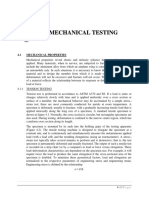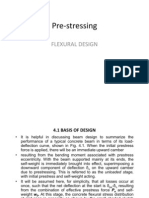Component Resistance-Deflection Function
Component Resistance-Deflection Function
Uploaded by
KhaleelCopyright:
Available Formats
Component Resistance-Deflection Function
Component Resistance-Deflection Function
Uploaded by
KhaleelOriginal Description:
Original Title
Copyright
Available Formats
Share this document
Did you find this document useful?
Is this content inappropriate?
Copyright:
Available Formats
Component Resistance-Deflection Function
Component Resistance-Deflection Function
Uploaded by
KhaleelCopyright:
Available Formats
Component resistance-
deflection function
Unlike conventional design, components designed
for blast are allowed to undergo a controlled
amount of plastic deformation. The component
absorbs strain energy during elastic and plastic
response that must equal the energy imparted by the
blast load, or the component will fail. Typically, a
well-designed ductile component will absorb most
of the blast load energy with plastic strain energy,
but the maximum component deflection will only
be half, or less, of the deflection corresponding to
failure.
The strain energy absorbed by a component during
response to blast load can be measured as the area
under its resistance-deflection curve at any given
Figure 5. Resistance-deflection relationship for simply supported precast concrete
deflection where the strain energy increases with
panel. Note: 1 in. = 25.4 mm; 1 psi = 6.9kPa.
deflection. The resistance-deflection curve relates
the resisted load to the midspan deflection of the
steel and concrete without any strength reduction factor. It is intended
blast-loaded component. It can be derived with
to be a realistic estimate of the actual dynamic moment capacity at the
conventional static calculation methods, including
maximum moment regions of the component.
applicable DIF and SIF factors. The resisted load in
the resistance-deflection curve has the same spatial Yield line theory is used to determine the ultimate resistance for
distribution as the applied blast load, typically a indeterminate components. These components have multiple yield
uniformly distributed pressure load. In a ductile loads, where the reinforcing steel at different maximum moment
reinforced concrete component, the resisted load, regions yields as the resisted load increases, which causes multiple
or resistance, increases approximately linearly with slopes in the resistance-deflection curves as illustrated in Fig. 6. The
deflection until the reinforcing steel yields in the resistance-deflection relationship of an indeterminate component can
maximum moment regions, and then the resistance be simplified, as shown in Fig. 6, using an equivalent stiffness kE and
remains relatively constant with increasing deflec- yield deflection xE that cause the simplified resistance-deflection curve,
tion until failure. with one slope, to have the same strain energy as the actual resistance-
deflection curve out to the deflection where the component becomes
The slope in Fig. 5 shows the resistance-deflection
a mechanism xp. Procedures for determining the resistance-deflection
curve for precast concrete components with simple
relationships for blast-loaded components are described in detail in a
supports. The initial slope is an average elastic
number of references.1,2
flexural stiffness. Typically this is calculated for
reinforced concrete components using an average The resistance-deflection relationship in Fig. 5 is arbitrarily stopped at
of the gross moment of inertia and the fully cracked
moment of inertia. The stiffness goes to zero when
yielding occurs at the maximum moment region.
The resistance does not degrade after yielding in
Fig. 5, implying ductile response. It is assumed that
the stress in the reinforcing steel remains constant
at fdy after yielding, ignoring the small amount
of strain hardening that occurs so that the resist-
ing moment and resistance remain constant with
increasing midspan deflection out to a limit
deflection.
In Fig. 5, a uniform pressure of 2.3 psi (16 kPa)
is resisted by the component when the applied
moment at midspan equals the ultimate dynamic
moment capacity and therefore causes yielding.
Thus, the ultimate resistance of the panel, equal
to the ultimate load capacity, is 2.3 psi (16 kPa)
at a midspan deflection of 0.45 in. (11 mm). The
ultimate dynamic moment capacity is calculated
Figure 6. Resistance-deflection relationships for determinate and indeterminate
using applicable DIF and SIF factors for reinforcing boundary conditions.
PCI Journal November–December 2007 57
You might also like
- Analytical Solutions For Flexural Design of Hybrid Steel Fiber ReinforcedNo ratings yetAnalytical Solutions For Flexural Design of Hybrid Steel Fiber Reinforced14 pages
- Seismic Design Requirements For Building Structures: Chapter C12No ratings yetSeismic Design Requirements For Building Structures: Chapter C123 pages
- Chapter 11. Member Hysteresis Models: LoadingNo ratings yetChapter 11. Member Hysteresis Models: Loading58 pages
- Brockenbrough. Structural Steel Designer's Handbook 3ed - Parte7No ratings yetBrockenbrough. Structural Steel Designer's Handbook 3ed - Parte75 pages
- Chapter 10 - Composite Beams: Flexural StrengthNo ratings yetChapter 10 - Composite Beams: Flexural Strength7 pages
- 2018 Hanssan Moehle Shear Strength of Exterior Beam Column Joint WO Transverse ReinforcementNo ratings yet2018 Hanssan Moehle Shear Strength of Exterior Beam Column Joint WO Transverse Reinforcement10 pages
- Effect of Limited Tension Stiffening in RC Elements Under Cyclic LoadsNo ratings yetEffect of Limited Tension Stiffening in RC Elements Under Cyclic Loads11 pages
- Chapter-4 Mechanical Testing 08-06-2014No ratings yetChapter-4 Mechanical Testing 08-06-201421 pages
- Simplification of Softened Strut-and-Tie Model For Strength Prediction of Discontinuity RegionsNo ratings yetSimplification of Softened Strut-and-Tie Model For Strength Prediction of Discontinuity Regions11 pages
- Seismic Analysis and Design: A Primer Recommended ReadingNo ratings yetSeismic Analysis and Design: A Primer Recommended Reading7 pages
- EMMEDUE STRUCTURAL ENGINEERING HANDBOOK_rev 3 (Recovered) (Recovered)No ratings yetEMMEDUE STRUCTURAL ENGINEERING HANDBOOK_rev 3 (Recovered) (Recovered)21 pages
- Moren - MODULE 5 - Eccentric ConnectionsNo ratings yetMoren - MODULE 5 - Eccentric Connections13 pages
- Pages From UBC 1997 - Uniform Building Code 12No ratings yetPages From UBC 1997 - Uniform Building Code 121 page
- MENG375 Machine Element I: Torsion & Static Failure TheoriesNo ratings yetMENG375 Machine Element I: Torsion & Static Failure Theories21 pages
- Effects of Damping Modelling On Results of Time-History Analysis of RC BridgesNo ratings yetEffects of Damping Modelling On Results of Time-History Analysis of RC Bridges12 pages
- Toniolo-DiPrisco2017 Chapter CentredAxialForceNo ratings yetToniolo-DiPrisco2017 Chapter CentredAxialForce85 pages
- ETJ - Volume 39 - Issue 12 - Pages 1821-1827No ratings yetETJ - Volume 39 - Issue 12 - Pages 1821-18277 pages
- Strengthening Effects of DFRCC Layers Applied To RC Flexural Members-Numerical Investigation only-SK Shin-2011No ratings yetStrengthening Effects of DFRCC Layers Applied To RC Flexural Members-Numerical Investigation only-SK Shin-20116 pages
- East Sitra Housing Development: Schedule of ColumnNo ratings yetEast Sitra Housing Development: Schedule of Column1 page
- PDF Compression, Ocr, Web-Optimization With Cvision'S PdfcompressorNo ratings yetPDF Compression, Ocr, Web-Optimization With Cvision'S Pdfcompressor1 page
- Introduction To The Tenth Edition: PDF Compression, Ocr, Web-Optimization With Cvision'S PdfcompressorNo ratings yetIntroduction To The Tenth Edition: PDF Compression, Ocr, Web-Optimization With Cvision'S Pdfcompressor1 page
- PDF Compression, Ocr, Web-Optimization With Cvision'S PdfcompressorNo ratings yetPDF Compression, Ocr, Web-Optimization With Cvision'S Pdfcompressor1 page
- 2.8.1 Active Pressures of Retained and Contained MaterialsNo ratings yet2.8.1 Active Pressures of Retained and Contained Materials1 page
- Design Calculations: Job No.: Revision: DateNo ratings yetDesign Calculations: Job No.: Revision: Date1 page
- An Overview of Chinese Fluorochemicals Industry - Eve ZhangNo ratings yetAn Overview of Chinese Fluorochemicals Industry - Eve Zhang24 pages
- Indian Standard - Code of Safety For MethanolNo ratings yetIndian Standard - Code of Safety For Methanol22 pages
- White Paper - Blow Molding TPOs With High Melt Strength Polyolefin ElastomersNo ratings yetWhite Paper - Blow Molding TPOs With High Melt Strength Polyolefin Elastomers4 pages
- Technical Passport Installation and Operation Manual For Authorized Installer / Service ShopNo ratings yetTechnical Passport Installation and Operation Manual For Authorized Installer / Service Shop48 pages
- D.K.T.E.S Textile & Engineering Institute, Ichalkaranji-416115 (M.H), India, February 1, 2014No ratings yetD.K.T.E.S Textile & Engineering Institute, Ichalkaranji-416115 (M.H), India, February 1, 201410 pages
- 22020n MSS WAS BO Monitoring BE CH 2021 GeneralNo ratings yet22020n MSS WAS BO Monitoring BE CH 2021 General6 pages
- Mass and Energy Balances - Stripping Section and Partial Reboiler100% (1)Mass and Energy Balances - Stripping Section and Partial Reboiler45 pages
- Optimization of Calcium Carbonate (Caco) Loading in Natural Rubber Latex Based Disposable GlovesNo ratings yetOptimization of Calcium Carbonate (Caco) Loading in Natural Rubber Latex Based Disposable Gloves4 pages
- Modern Physics & Electronics Course Code: PHYS2114 Lecture No.1 Black Body RadiationsNo ratings yetModern Physics & Electronics Course Code: PHYS2114 Lecture No.1 Black Body Radiations22 pages
- Coal Fly Ash: Material Safety Data SheetNo ratings yetCoal Fly Ash: Material Safety Data Sheet3 pages





































































































